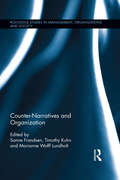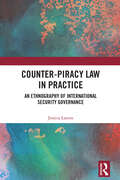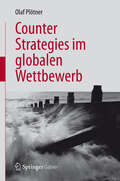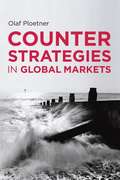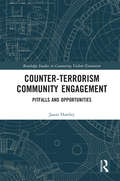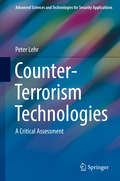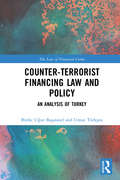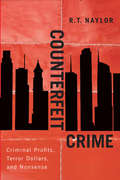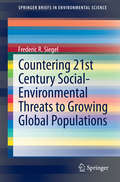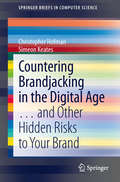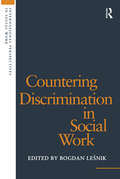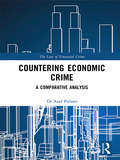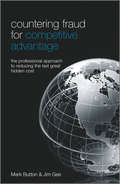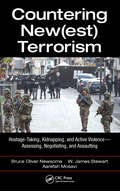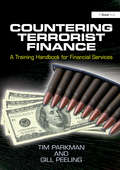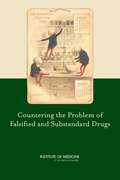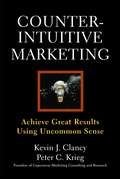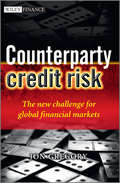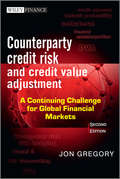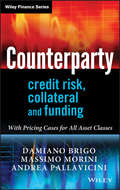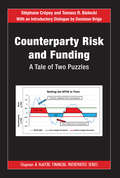- Table View
- List View
Counter-Narratives and Organization (Routledge Studies in Management, Organizations and Society #39)
by Timothy Kuhn Sanne Frandsen Marianne Wolff LundholtCounter-Narratives and Organization brings the concept of "counter-narrative" into an organizational context, illuminating these complex elements of communication as intrinsic yet largely unexplored aspect of organizational storytelling. Departing from dialogical, emergent and processual perspectives on "organization," the individual chapters focus on the character of counter-narratives, along with their performative aspects, by addressing questions such as: how do some narratives gain dominance over others? how do narratives intersect, relate and reinforce each other how are organizational members and external stakeholders engaged in the telling and re-telling of the organization? The empirical case studies provide much needed insights on the function of counter-narratives for individuals, professionals and organizations in navigating, challenging, negotiating and replacing established dominant narratives about "who we are," "what we believe," "what we do" as a collective. The book has an interdisciplinary scope, drawing together ideas from both storytelling in organization studies, the communicative constitution of organization (CCO) from organizational communication, and traditional narratology from humanities. Counter-Narratives and Organization reflects an ambition to spark readers’ imagination, recognition, and discussion of organization and counter-narratives, offering a route to bring this important concept to the center of our understandings of organization.
Counter-Piracy Law in Practice: An Ethnography of International Security Governance
by Jessica LarsenThis book is a socio-legal study of counter-piracy. It takes as its case the law enforcement efforts after 2008 to suppress piracy off the coast of Somalia. Through ethnographic fieldwork, the book invites the reader onto a Danish warship patrolling the western Indian Ocean for piracy incidents and into the courtroom in Seychelles, where more than 150 suspects were prosecuted. The aim is to understand how counter-piracy worked in practice. The book uses assemblage theory to approach law as a social process and places emphasis on studying empirical enforcement practices over analysing legal provisions. This supplements existing scholarship on the legal aspects of counter-piracy. Scholarship has mainly examined applicable law governing counter-piracy. This book steps into the field to examine applied law. Its methodology renders visible areas of legal ambiguity and identifies practices that suggest impunity and question legal certainty. It thus contributes with new policy-relevant knowledge for international security governance. The relevance is one of urgency. Counter-piracy off Somalia has served as a governance paradigm, which is replicated in other maritime domains. Consideration of the implications for policy is therefore needed. The book will be of interest to policy-makers, security practitioners and scholars who share a methodological commitment to practice.
Counter Strategies im globalen Wettbewerb
by Olaf PlötnerDie Wettbewerbssituation etablierter Technologieunternehmen verändert sich mit neuen Kunden und Wettbewerben aus den Schwellen- und Entwicklungsländern rasant. Anders als gewohnt, verlangen die neuen Käufer über technisch perfekte Produkte hinaus preiswerte Alternativen. Der Autor diskutiert neue Strategien, mit denen sich Technologieunternehmen erfolgreich behaupten können und liefert Vorschläge für die Umsetzung bei der Produkt- und Preisgestaltung, der Mitarbeiter- und Organisationsentwicklung sowie beim Marken- und Vertriebsmanagement.
Counter Strategies in Global Markets
by Olaf PloetnerDeveloping BRIC markets are changing the business models of traditional western technology leaders. Classic business strategies are no longer suitable for companies attacking abroad whilst defending their market at home. Based on real-life cases, the book evaluates the best new strategies for western companies in technology-based B2B markets.
Counter-Terrorism Community Engagement: Pitfalls and Opportunities (Routledge Studies in Countering Violent Extremism)
by Jason HartleyThis book offers insights into the building of trust in Muslim communities through community engagement in a climate of counter-terrorism. Police engagement with Muslim communities is complex with a history of distrust. This book first attempts to understand the role and implications of uncertainty on community engagement in Muslim communities, and then explores the cultural nuances associated with the demonstration of trustworthiness, and decisions to bestow trust. It further highlights the complexities and implications for Muslim leaders when trying to simultaneously engage police and appease their own communities; the book exposes community perceptions of an over-reaction by authorities that has moved suspicion from a handful of terrorists to the entire Muslim community, resulting in problematic community perceptions that Muslim communities are being targeted by police. The findings suggest that the intentionality of police is a highly significant consideration in trust negotiations, and reveals a number of cultural preferences considered critical to trust negotiations. The book further highlights opportunities to enhance the development of trust and avoid pitfalls that can be problematic to community engagement. The lessons learned seek to enhance the existing body of literature regarding strategies and resources to improve counter-terrorism community engagement with Muslim communities. This book will be of much interest to students of counter-terrorism, preventing violent extremism, deradicalization, and security studies.
Counter-Terrorism Technologies: A Critical Assessment (Advanced Sciences and Technologies for Security Applications)
by Peter LehrThis book critically discusses the role of technology for counter-terrorism in general, and for securing our vulnerable open societies in particular. It is set against the backdrop of the terrorist threat posed by the combined forces of Al Qaeda and ISIS/Daesh in the foreseeable future. The book commences by illuminating current and foreseeable tactics and weapons used by these implacable enemies – weapons that may well include chemical, biological, radiological and potentially even nuclear (CBRN) devices. In a second part, it introduces technologies already available or in development that promise an increase in safety and security when it comes to the dangers posed by these terrorists. This part also includes a critical discussion of advantages and disadvantages of such technologies that are, quite often, sold as a ‘silver bullet’ approach in the fight against terrorism. Controversies such as those triggered by the abuse of millimeter wave scanners deployed at several Western European airports will demonstrate that there are costs involved with regard to human rights. The third, analytical part takes the critical discussion further by arguing that the uncritical fielding of new surveillance and control technologies in parallel with the on-going outsourcing and privatization of key services of the state could well lead to dystopias as envisaged in a rather prescient way by the so-called cyperpunk novels of the 1980s. The book concludes with the question that any liberal democracy should ask itself: how far can we go with regard to hardening our societies against terrorist threats?
Counter-Terrorist Financing Law and Policy: An analysis of Turkey (The Law of Financial Crime)
by Burke Uğur Başaranel Umut TürkşenSince the 9/11 attacks the world has witnessed the creation of both domestic and international legal instruments designed to disrupt and interdict the financial activities of terrorists. This book analyses the counter-terrorist financing law (CTF), policy and practice at the national level, focusing on Turkey. The work examines the limits and capabilities of CTF efforts on terrorism threats and determines the effectiveness of CTF efforts in Turkey, a country which has a pivotal role in terms of countering terrorism regionally and internationally. <P><P>The Turkish case-study is supported by an empirical study involving 37 semi-structured interviews with CTF practitioners and law enforcement experts with different affiliations and backgrounds. The findings illustrate that Turkey’s CTF system has not obtained an adequate level of effectiveness as a result of lack of proper implementation of its policy in the bureaucratic, legal and operational spheres. It is evident that the administrative and legal systems in Turkey are established according to the ‘one-size-fits-all’ international CTF standards and thus are compliant with the international CTF benchmarks, yet the interviews reveal significant challenges at the implementation level including lack of training and financial security, heavy handed bureaucracy, inadequate coordination and communication between international and national levels. <P><P>The book will be an invaluable resource for academics, students and policy-makers working in the areas of financial crime and terrorism.
Countercyclical Macro Prudential Policies in a Supporting Role to Monetary Policy
by Papa N'DiayeA report from the International Monetary Fund.
Counterfeit Crime
by R. T. NaylorIn Counterfeit Crime, economist, historian, and criminologist R.T. Naylor dissects the costs - economic, social, and political - of the seemingly never-ending wars on the grossly exaggerated menaces of Crime and Terror and how most things politicians do to combat them make matters worse - for the public and the public good. He explains how the post-World War II welfare state, with its commitment to building public infrastructure, maintaining social security, and providing accessible education, gave way to the modern executive state, with its focus on guaranteeing corporate welfare, dropping bombs on countries too weak to fight back, and manipulating the thoughts and actions of populations kept in line by the carrot of glitzy toys and the stick of ever-heavier legal sanctions. He dissects how the canons of free-market fundamentalism, backed by the cannons of state power, paved the road toward a soft form of totalitarianism, which march hand in hand with millennial Christianity and a military-security-industrial complex in search for new - mostly imaginary - enemies. Counterfeit Crime is savage in its critique of the political and judicial status quo and outraged at an economy rife with corruption.
Counterfeit Crime: Criminal Profits, Terror Dollars, and Nonsense
by R.T. NaylorIn Counterfeit Crime, economist, historian, and criminologist R.T. Naylor dissects the costs - economic, social, and political - of the seemingly never-ending wars on the grossly exaggerated menaces of Crime and Terror and how most things politicians do to combat them make matters worse - for the public and the public good. He explains how the post-World War II welfare state, with its commitment to building public infrastructure, maintaining social security, and providing accessible education, gave way to the modern executive state, with its focus on guaranteeing corporate welfare, dropping bombs on countries too weak to fight back, and manipulating the thoughts and actions of populations kept in line by the carrot of glitzy toys and the stick of ever-heavier legal sanctions. He dissects how the canons of free-market fundamentalism, backed by the cannons of state power, paved the road toward a soft form of totalitarianism, which march hand in hand with millennial Christianity and a military-security-industrial complex in search for new - mostly imaginary - enemies. Counterfeit Crime is savage in its critique of the political and judicial status quo and outraged at an economy rife with corruption.
Countering 21st Century Social-Environmental Threats to Growing Global Populations (SpringerBriefs in Environmental Science)
by Frederic R. SiegelThis book brings together in a single volume a grand overview of solutions - political, economic, and scientific - to social and environmental problems that are related to the growth of human populations in areas that can least cope with them now. Through progressive adaptation to social and environmental changes projected for the future, including population growth, global warming/climate change, water deficits, and increasing competition for other natural resources, the world may be able to achieve a fair degree of sustainability for some time into the future.
Countering Brandjacking in the Digital Age: … and Other Hidden Risks to Your Brand (SpringerBriefs in Computer Science)
by Christopher Hofman Simeon KeatesThe rise of the Internet and social media in particular offer great opportunities for brand owners to increase business and brand recognition. While this has clearly been of benefit to brand owners, who have seen a consequent rise in the value of their brands, it simultaneously makes those brands more attractive for exploitation or attack by others. Brand risks can come in many different types and this book provides examples of how these risks can arise as well as providing quantitative estimates of the adverse impacts that can result from such risks. Brand owners need to be aware of the risks and of the need to develop strategies for identifying and managing them. This book details the process by which a brand owner can develop a brand risk management process to protect a brand's reputation and value. Rather than prescribe a one-size-fits-all approach, the authors provide guidance on how a brand risk management process can be tailored to particular needs and circumstances. This approach is underpinned by drawing on examples of best practice in the fields of risk management, interaction design and engineering design. This combined approach relies on developing an understanding of the risks faced by a particular brand owner, the full context of those risks and also the brand owner's capabilities for identifying and managing those risks. This book contains many real-world examples and interviews with a number of brand owning organisations ranging from small companies to large multinationals.
Countering Cyber Sabotage: Introducing Consequence-Driven, Cyber-Informed Engineering (CCE)
by Sarah Freeman Andrew A. BochmanCountering Cyber Sabotage: Introducing Consequence-Driven, Cyber-Informed Engineering (CCE) introduces a new methodology to help critical infrastructure owners, operators and their security practitioners make demonstrable improvements in securing their most important functions and processes. Current best practice approaches to cyber defense struggle to stop targeted attackers from creating potentially catastrophic results. From a national security perspective, it is not just the damage to the military, the economy, or essential critical infrastructure companies that is a concern. It is the cumulative, downstream effects from potential regional blackouts, military mission kills, transportation stoppages, water delivery or treatment issues, and so on. CCE is a validation that engineering first principles can be applied to the most important cybersecurity challenges and in so doing, protect organizations in ways current approaches do not. The most pressing threat is cyber-enabled sabotage, and CCE begins with the assumption that well-resourced, adaptive adversaries are already in and have been for some time, undetected and perhaps undetectable. Chapter 1 recaps the current and near-future states of digital technologies in critical infrastructure and the implications of our near-total dependence on them. Chapters 2 and 3 describe the origins of the methodology and set the stage for the more in-depth examination that follows. Chapter 4 describes how to prepare for an engagement, and chapters 5-8 address each of the four phases. The CCE phase chapters take the reader on a more granular walkthrough of the methodology with examples from the field, phase objectives, and the steps to take in each phase. Concluding chapter 9 covers training options and looks towards a future where these concepts are scaled more broadly.
Countering Discrimination in Social Work (International Perspectives in Social Work)
by Bogdan LešnikDiscrimination? Isn't there enough talk about discrimination? Yes, indeed. That is why we have to begin countering discrimination. We need strategies that will make it inoperative or at least limit its scope. But first, we need to think how discrimination works and identify it where it works. It concerns far more than mere procedural hitches for which a few legal provisions will do. Countering Discrimination (Volume 1998 of International Perspectives in Social Work yearbook) brings papers that analyse mechanisms of social discrimination in a variety of such locations and bring proposals for counter-strategies. This is essential in social work if causes, rather than manifestations, of the problems it is concerned with are to be addressed. But it is also essential that everybody who opposes discrimination recognise its subtle and dispersed ways of operation in the human services, regardless of their own basic field of work. In this respect, the book will be useful to a very wide audience.
Countering Economic Crime: A Comparative Analysis (The Law of Financial Crime)
by Axel PalmerEconomic crime is a significant feature of the UK’s economic landscape and yet despite the government’s bold mission statements ‘to hold those suspected of financial wrongdoing to account’ as part of their ‘day of reckoning’ and ‘serious about white-collar crime’ agenda, there is a sense that this is still not being done effectively. This book examines the history of the creation of the UK’s anti-economic crime institutions and accompanying legislation, providing a critique of their effectiveness. The book analyses whether the recent regulatory regime is fit for purpose as well as being appropriate for the future. In order to explore how the UK’s economic crime strategies could be improved the book takes a comparative approach analysing policy and legislative responses to economic crime in the United States and Australia in order to determine whether the UK could or should import similar structures or laws to improve the enforcement of UK economic crime.
Countering Fraud for Competitive Advantage
by Jim Gee Mark ButtonSubstantially reduce the largely hidden cost of fraud, and reap a new competitive advantage. As the title suggests, Countering Fraud for Competitive Advantage presents a compelling business case for investing in anti-fraud measures to counter financial crime. It looks at the ways of reaping a new competitive advantage by substantially reducing the hidden cost of fraud. Aimed at a wide business community and based on solid research, it is the only book to put forward an evidence-based model for combating corporate fraud and financial crime. Despite its increase and capture of the news headlines, corporate fraud is largely ignored by most organizations. Fraud is responsible for losses of up to nine percent of revenues--sometimes more. Yet, most organizations don't believe they have a problem and don't always measure fraud losses. This highlights an area for capturing a competitive advantage--with the right counter-fraud strategy, massive losses due to the cost of fraud can be reduced for a fraction of the return. Advocates a new model for tackling fraud and illustrates theories with best practice examples from around the world The authors have close links with the Counter Fraud Professional Accreditation Board: Jim Gee is a world-renowned expert in the field, and has advised private companies and governments from more than 35 countries. Mark Button is Director of the leading Centre for Counter Fraud Studies, Portsmouth University, U.K. Organizations are losing millions of dollars to fraud. This book outlines a comprehensive approach to reducing financial crime and helping return some of the revenue lost to the cost of fraud.
Countering New(est) Terrorism: Hostage-Taking, Kidnapping, and Active Violence — Assessing, Negotiating, and Assaulting
by Bruce Oliver Newsome James W. Stewart Aarefah MosaviHow should we analyze and assess new terrorist behaviors? What are the particular risks and challenges from new terrorism? Should we negotiate with terrorists, and, if so, how? When should we use force against terrorists? Countering New(est) Terrorism: Hostage-Taking, Kidnapping, and Active Violence—Assessing, Negotiating, and Assaulting improves our knowledge of new terrorist behaviors, and our skills in responding to such attacks. The term "new terrorism" has been in circulation since the late 90’s. This book analyzes the "newest terrorism" that has emerged in recent years—characterized by increased hostage-taking, kidnapping, and active violence—and develops best practices for countering these emerging threats. Along the way, it challenges fashionable wishful thinking that all terrorists are open to rational negotiation or de-radicalization, that military responses always reflect badly on the official side, and that terrorists are not constrained by their own doctrines. The new terrorists are dramatically more ideological, murderous, and suicidal. They are generally less reconcilable, less trusting of official negotiators, less likely to release detainees, and more likely to kill detainees. They are less likely to demand ransoms yet more likely to release hostages in cases in which they do demand ransom. They are more informed about the official side’s policies, tactics, techniques, and procedures. They are more likely to use new information and communication technologies against responding agencies and officials. They are more capable fighters—they kill more people despite deploying fewer fighters per hostage. Most disturbing is the fact that they take advantage of free-er societies to access easier targets. Features: Includes evidence-based definitions and descriptions of political, religious, Jihadi, and new terrorism Presents the first large-n comparison of old and new terrorism, using an original extension of the Global Terrorism Database (GTD), with added codes for each of 10,735 hostage crises and more than 500,000 data points from 1970 through 2016 Details a further extension of the GTD covering all terrorist events from 2004 through 2016, roughly 5 million data points. Offers prescriptive advice and visual decision trees on how to negotiate crises, assess the risk of terrorism, and how and when to assault terrorists Reviews official practices, interviews with experienced officials, and real-world simulations of recent terrorist events and attacks Countering New(est) Terrorism will be of interest to researchers, students enrolled in terrorism and Homeland Security programs, crisis negotiators, and police, security, intelligence, and military authorities tasked with counterterrorism and anti-terrorism efforts.
Countering Terrorist Finance: A Training Handbook for Financial Services
by Tim Parkman Gill PeelingRegulation and control of the financial industry has become the weapon of choice for governments struggling to control the rise in global crime and terrorism. Tim Parkman and Gill Peeling's Countering Terrorist Finance - A Training Handbook for Financial Services is a practical, specialist guide for training staff in financial institutions in the processes and skills needed to respond to terrorist financing activities. The book explains international legal responses and obligations (with particular jurisdictional emphasis on the US, the UK, and Hong Kong); dissects the financing typologies behind terrorist attacks including September 11th, Madrid, Bali and other non al-Qaeda examples; analyzes potential causes for suspicion and offers an overview of the main issues and considerations affecting compliance professionals, in their efforts to protect against terrorist financing. The accompanying collection of eight training activities, with supporting materials and presentation slides, provides compliance officers with a resource for developing awareness and appropriate behaviour amongst employees tasked with managing terrorist finance risk. Additional training resource materials, including Powerpoint presentations, audio visual slideshows and pdf handouts are available on a CD ROM that accompanies the book. The background material, practical advice and training resources make this collection an excellent starting point for organizations striving to make a difference in this complex and difficult area.
Countering the Problem of Falsified and Substandard Drugs
by Lawrence O. GostinThe adulteration and fraudulent manufacture of medicines is an old problem, vastly aggravated by modern manufacturing and trade. In the last decade, impotent antimicrobial drugs have compromised the treatment of many deadly diseases in poor countries. More recently, negligent production at a Massachusetts compounding pharmacy sickened hundreds of Americans. While the national drugs regulatory authority (hereafter, the regulatory authority) is responsible for the safety of a country's drug supply, no single country can entirely guarantee this today. The once common use of the term counterfeit to describe any drug that is not what it claims to be is at the heart of the argument. In a narrow, legal sense a counterfeit drug is one that infringes on a registered trademark. The lay meaning is much broader, including any drug made with intentional deceit. Some generic drug companies and civil society groups object to calling bad medicines counterfeit, seeing it as the deliberate conflation of public health and intellectual property concerns. Countering the Problem of Falsified and Substandard Drugs accepts the narrow meaning of counterfeit, and, because the nuances of trademark infringement must be dealt with by courts, case by case, the report does not discuss the problem of counterfeit medicines.
Counterintuitive Marketing: Achieving Great Results Using Common Sense
by Kevin J. Clancy Peter C. KriegWhy does American business seem to sputter along where it ought to thrive? What is the source of the current plague of downsizing, disappearing companies, dot-com crashes, and here-today-gone-tomorrow advertising campaigns? Why do more products flop than ever before? Marketing experts Kevin J. Clancy and Peter C. Krieg have the answers. In Counterintuitive Marketing, Clancy and Krieg trace the high rate of business failure back to bad marketing strategy, and the even worse implementation of that strategy. Excess testosterone, they argue, compels senior managers to make decisions intuitively, instinctively, quickly, and, unfortunately, disastrously. In this informative and enlightening book, Clancy and Krieg confront these "over-and-over-again" marketers, who don't have time to do it right the first time, but endless time and a company bankroll to do it wrong over and over again. The authors draw from their decades of consumer and business-to-business marketing experience to describe the intuitive decision-making practices that permeate business today, and demonstrate how these practices lead to disappointing performance. Chapter by chapter, Counterintuitive Marketing contrasts how marketing decisions are made today with how they should be made. The authors give equal treatment to targeting, positioning, product development, pricing, customer service, e-commerce, marketing planning, implementation, and more as they present counterintuitive ideas for building and introducing blockbuster marketing programs. Readers will discover in this iconoclastic treasure chest hundreds of penetrating insights that have enabled the authors' firm, Copernicus, to transform companies and become a "brand guardian" to the Fortune 500 and emerging businesses around the world. The tools to create exceptional marketing programs really do exist, and they are all here in Counterintuitive Marketing, the ultimate practical guide for any company of any size.
Counternetwork: Countering the Expansion of Transnational Criminal Networks
by Angel Rabasa Christopher M. Schnaubelt Douglas Farah Gregory Midgette Howard J. Shatz Peter ChalkThrough an analysis of transnational criminal networks originating in South America, this report presents operational characteristics of these networks, strategic alliances they have established, and the multiple threats that they pose to U.S. interests and to the stability of the countries where they operate. It also identifies U.S. government policies and programs to counter these networks and examines the military’s role in that context.
Counterparty Credit Risk
by Jon GregoryThe first decade of the 21st Century has been disastrous for financial institutions, derivatives and risk management. Counterparty credit risk has become the key element of financial risk management, highlighted by the bankruptcy of the investment bank Lehman Brothers and failure of other high profile institutions such as Bear Sterns, AIG, Fannie Mae and Freddie Mac. The sudden realisation of extensive counterparty risks has severely compromised the health of global financial markets. Counterparty risk is now a key problem for all financial institutions. This book explains the emergence of counterparty risk during the recent credit crisis. The quantification of firm-wide credit exposure for trading desks and businesses is discussed alongside risk mitigation methods such as netting and collateral management (margining). Banks and other financial institutions have been recently developing their capabilities for pricing counterparty risk and these elements are considered in detail via a characterisation of credit value adjustment (CVA). The implications of an institution valuing their own default via debt value adjustment (DVA) are also considered at length. Hedging aspects, together with the associated instruments such as credit defaults swaps (CDSs) and contingent CDS (CCDS) are described in full. A key feature of the credit crisis has been the realisation of wrong-way risks illustrated by the failure of monoline insurance companies. Wrong-way counterparty risks are addressed in detail in relation to interest rate, foreign exchange, commodity and, in particular, credit derivative products. Portfolio counterparty risk is covered, together with the regulatory aspects as defined by the Basel II capital requirements. The management of counterparty risk within an institution is also discussed in detail. Finally, the design and benefits of central clearing, a recent development to attempt to control the rapid growth of counterparty risk, is considered. This book is unique in being practically focused but also covering the more technical aspects. It is an invaluable complete reference guide for any market practitioner with any responsibility or interest within the area of counterparty credit risk.
Counterparty Credit Risk and Credit Value Adjustment
by Jon GregoryA practical guide to counterparty risk management and credit value adjustment from a leading credit practitionerSince the collapse of Lehman Brothers and the resultant realization of extensive counterparty risk across the global financial markets, the subject of counterparty risk has become an unavoidable issue for every financial institution. This book explains the emergence of counterparty risk and how financial institutions are developing capabilities for valuing it. It also covers portfolio management and hedging of credit value adjustment, debit value adjustment, and wrong-way counterparty risks. In addition, the book addresses the design and benefits of central clearing, a recent development in attempts to control the rapid growth of counterparty risk. This uniquely practical resource serves as an invaluable guide for market practitioners, policy makers, academics, and students.
Counterparty Credit Risk, Collateral and Funding
by Andrea Pallavicini Damiano Brigo Massimo MoriniThe book's content is focused on rigorous and advanced quantitative methods for the pricing and hedging of counterparty credit and funding risk. The new general theory that is required for this methodology is developed from scratch, leading to a consistent and comprehensive framework for counterparty credit and funding risk, inclusive of collateral, netting rules, possible debit valuation adjustments, re-hypothecation and closeout rules. The book however also looks at quite practical problems, linking particular models to particular 'concrete' financial situations across asset classes, including interest rates, FX, commodities, equity, credit itself, and the emerging asset class of longevity.The authors also aim to help quantitative analysts, traders, and anyone else needing to frame and price counterparty credit and funding risk, to develop a 'feel' for applying sophisticated mathematics and stochastic calculus to solve practical problems.The main models are illustrated from theoretical formulation to final implementation with calibration to market data, always keeping in mind the concrete questions being dealt with. The authors stress that each model is suited to different situations and products, pointing out that there does not exist a single model which is uniformly better than all the others, although the problems originated by counterparty credit and funding risk point in the direction of global valuation.Finally, proposals for restructuring counterparty credit risk, ranging from contingent credit default swaps to margin lending, are considered.
Counterparty Risk and Funding: A Tale of Two Puzzles (Chapman and Hall/CRC Financial Mathematics Series #31)
by Stéphane Crépey Tomasz R. Bielecki Damiano BrigoSolve the DVA/FVA Overlap Issue and Effectively Manage Portfolio Credit Risk Counterparty Risk and Funding: A Tale of Two Puzzles explains how to study risk embedded in financial transactions between the bank and its counterparty. The authors provide an analytical basis for the quantitative methodology of dynamic valuation, mitigation, and hedging of bilateral counterparty risk on over-the-counter (OTC) derivative contracts under funding constraints. They explore credit, debt, funding, liquidity, and rating valuation adjustment (CVA, DVA, FVA, LVA, and RVA) as well as replacement cost (RC), wrong-way risk, multiple funding curves, and collateral. The first part of the book assesses today’s financial landscape, including the current multi-curve reality of financial markets. In mathematical but model-free terms, the second part describes all the basic elements of the pricing and hedging framework. Taking a more practical slant, the third part introduces a reduced-form modeling approach in which the risk of default of the two parties only shows up through their default intensities. The fourth part addresses counterparty risk on credit derivatives through dynamic copula models. In the fifth part, the authors present a credit migrations model that allows you to account for rating-dependent credit support annex (CSA) clauses. They also touch on nonlinear FVA computations in credit portfolio models. The final part covers classical tools from stochastic analysis and gives a brief introduction to the theory of Markov copulas. The credit crisis and ongoing European sovereign debt crisis have shown the importance of the proper assessment and management of counterparty risk. This book focuses on the interaction and possible overlap between DVA and FVA terms. It also explores the particularly challenging issue of counterparty risk in portfolio credit modeling. Primarily for researchers and graduate students in financial mathematics, the book is also suitable for financial quants, managers in banks, CVA desks, and members of supervisory bodies.
